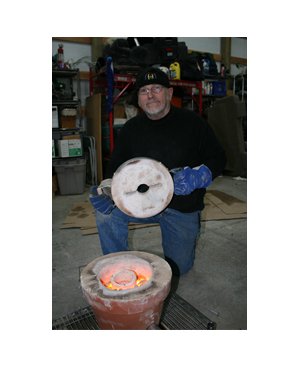Description
“If ever there was a first book to start a Blacksmith’s Bookshelf with then this is it. As an aside, if anyone wants to get a feel for what a good drawing looks like, get this book.” – George Dixon, The Hammer’s Blow
“Clear words, excellent pictures, good explanations, tables, charts…all you need to encourage you to pick up a hammer and start hammering. I urge all my students to buy, read, use and then reread this book.” – Nol Putnam, The Plains
This book is a tool for blacksmiths. With drawings, photographs and charts it describes the forging processes of heating, upsetting, drawing out, forge welding, metallurgy and tool making.
The tenet of this book is to provide a tool for blacksmiths. It explains the process of design, the use of a computer in metal design, how to set up a business and manage it.
Providing an inspiration for all artist-blacksmiths are portfolios of the wrought iron work of Martin Rose and Samuel Yellin, two of America’s premier metalworkers of the past. To further inspire and to show the new focus of blacksmithing in the metal arts, six contemporary metalworkers show a series of demonstration pieces of their iron work. This 256 page book is bound with an improved binding system (Otabind) that allows the pages to lay flat.
SAMPLE CHAPTER
Metallurgy for the Blacksmith
Metallurgy is the science and technology of metals. It concerns the extraction of metals from their ores, the refining of metals and the relationships between physical and mechanical properties of metals and their composition, mechanical working and heat treatment. Metallurgical information is helpful to any blacksmith, whether he is doing general blacksmithing or tool making. If you are a general blacksmith, then you need only understand the very basic principles; however, if you are a tool smith, then you will need a broader understanding. This does not mean that you will have to be a metallurgical engineer to make good tools, but that with some metallurgical knowledge, you will be able to select the correct material, forge it properly and heat treat it to develop the desired physical properties.
The basic forging processes are made possible because the iron becomes plastic and can be forged when it is heated to a cherry red and above, up to a light yellow. Iron can be welded when it is heated to a light yellow. When heated to a dazzling white, iron begins to melt and “burns;” this destroys the metal for forging purposes.
The structure of iron and all its alloys is crystalline. Plastic deformation of crystals is possible through the generation and motion of crystal defects called “dislocations.” These deformation processes operate with less deformation force as the temperature of the iron is increased. Thus, when iron is heated, it becomes more plastic. Generally, the higher the heat, the easier it is to form the metal.
A piece of iron is actually composed of many individual iron crystals, called grains, each having a different orientation of its crystal axes in relation to the neighboring grains. Normally, the grain size is too small to observe without the aid of a microscope. Sometimes, a fractured piece of iron will show evidence of the individual grains of iron that are visible to the unaided eye. The grain size is very important for determining the strength of iron: the more refined (smaller) the grain size, the stronger the iron and the tougher (resistance to fracture on impact) it is.
There are two factors affecting the grain size that the smith can control at the forge: the temperature of the metal and the nature of the mechanical working (forging).
When iron is heated and then forged, the forging refines, or makes the grain smaller. This hammer refining must continue until the iron cools below the critical temperature. If the forging stops before the iron is cherry red, or the iron is reheated without further forging, the grain growth will resume.
Welding heat greatly increases the grain size. However, the weld can be hammer-refined to break up the coarse grain. With this type of control at the forge, the smith doing general metal work can resolve most problems.
Mild steel can be used for simple tools only. As a tool designer you must use special steels for tools that will be tough, hard and durable. To create these steels, alloying elements are added to the iron. The major alloying element added to iron is carbon. The chart of maximum attainable hardness shows the effect of increasing amounts of carbon in steel. Steels with only 35 to 45 points of carbon can be used where moderate hardness is required. (Steels begin to respond to heat treatment with around 35 points of carbon.)
Hardness is the ability of a metal to withstand being deformed by indentation. This can be measured by a machine called the “Rockwell hardness tester.” There are other tests, however, only the Rockwell C hardness scale will be referred to here. A relative degree of hardness can also be determined by a file. (See “File Test” in Resources.)
Chart 3 shows another relationship of carbon to iron: the differences of tempering temperatures on the hardness of three different steels for equal tempering times. Notice that there is a greater difference of hardness between the steel with 35 points of carbon and the one with 80 points than there is between the steel with 80 points and the one with 120 points.











